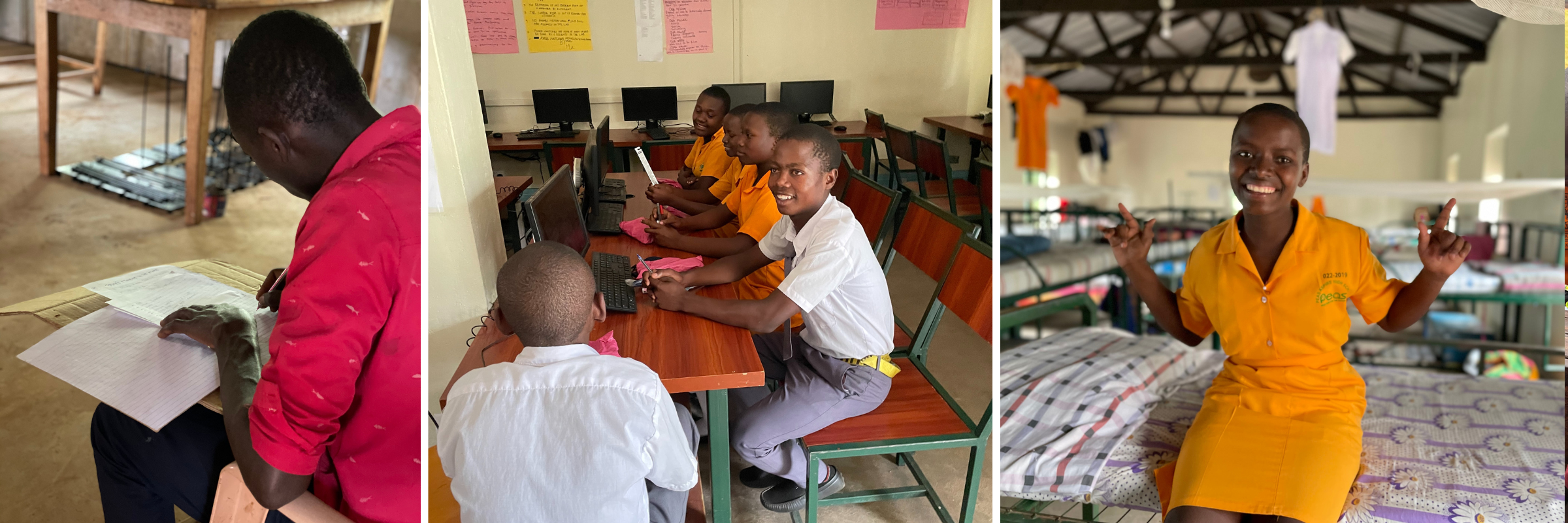Advanced Sponsorship
Secondary, vocational, & University

Primary Level
Primary school
Equivalent to Elementary & Middle School - Includes grades P1 - P7.
Children in primary school take four main subjects: English, Math, Science, and SST. SST stands for Social Studies, a subject that includes Geography, History, and Religious Studies. Students are examined at the end of every term in each of these subjects.
At the end of primary seven, pupils sit for their first major national exams – the primary leaving examinations (PLE). Presently, PLE has four examinable subjects – English language, mathematics, science, and social studies. The best possible mark pupils can achieve is a total of four (which means one point - a distinction - in each subject), while the worst is a total of 36 (nine points for each subject, which means a fail). The results of this test determine if they can pass on into secondary school or if they have failed and must repeat.
Secondary school
While nearly 90% of all Ugandan children attend some level of primary school, only 53% actually complete it. Out of those who are able to make it through their primary schooling, less than half continue on to secondary school or what we call high school.
Lower Secondary - "O" (Ordinary) Level -S1, S2, S3 & S4
The first phase of secondary academic education takes 4 years, at the end of which students must pass their O-Level exams before proceeding further to A-level. If they don't pass on to A- level, they may attend a vocational school or a technical college for 2-3 years instead.
Upper Secondary - "A" (Advanced) Level - S5 & S6
A successful A-Level pass opens up the possibility of tertiary education (university) for the lucky few who make it this far.
Vocational
When students cannot pass secondary school or would rather learn an important trade, we give them the option to attend a vocational school.
A vocational school, also called trade school or career school, is a form of education that is designed to teach students the valuable skills they need to perform a particular task or job.
These schools usually provide practical training that focuses on a single field such as nursing, mechanics, catering or carpentry.
Unlike traditional four-year colleges and universities, vocational schools focus on hands-on learning and experience, rather than academic theory. In vocational schools, students learn through practical applications of the subjects they are studying, which is a great advantage when it comes to job readiness. This means that graduates of vocational schools are well-equipped to enter the workforce immediately upon graduation, armed with the practical skills and knowledge required to succeed in their chosen field. Vocational schools are a great option for those who are looking for a more streamlined and focused approach to their education.
University
Students who pass their secondary school A-levels may go on to university, where they can study for degrees, or to other institutions that award diplomas and certificates. Some tertiary institutions, like primary teachers' colleges and some nursing schools, also admit students who have only completed their O-levels (S1-S4).
The importance of a university education is highlighted by the fact that only a small percentage of the population has access to tertiary education due to limited spaces in universities, high academic requirements, and financial barriers.
The Ugandan government also recognizes the significance of university education for national development and has invested in increasing the number of universities and enhancing the quality of education. Consequently, many Ugandan parents prioritize sending their children to university, often struggling to pay tuition fees and other costs associated with higher education. University education is generally seen as a pathway to secure high-paying jobs, which can help individuals and families escape poverty. As such, pursuing university education is often viewed as a key strategy for social mobility and improving one's economic and social status.
Why is advanced sponsorship more expensive?
Secondary School students (grades S1-S6) are able to dive deep into their educational interests. They learn diverse subjects from skilled teachers, attend labs & conferences, and receive additional resources like scholastic materials & evening tutoring. Students in S4, S5, & S6 enter the boarding program and are guaranteed three meals a day, a safe haven to sleep and study from, a comfortable bed & necessary boarding supplies. Our Advanced Sponsorship Program also includes Vocational School for students who choose to learn a trade and University for the brightest students who pass the challenging upper Secondary (A-level) courses. While higher education creates greater transformations, it also brings greater costs.
Secondary School is a unique program where each year the costs and needs may fluctuate slightly based on the student needs and requirements of the school. The first three years of the secondary program are less intensive (S1, S2, and S3) and students can remain in the day program (while still taking advantage of extra preps and programs before and after school), while the final three years (S4, S5, and S6) require student boarding in order for them to have the best chance of success.



